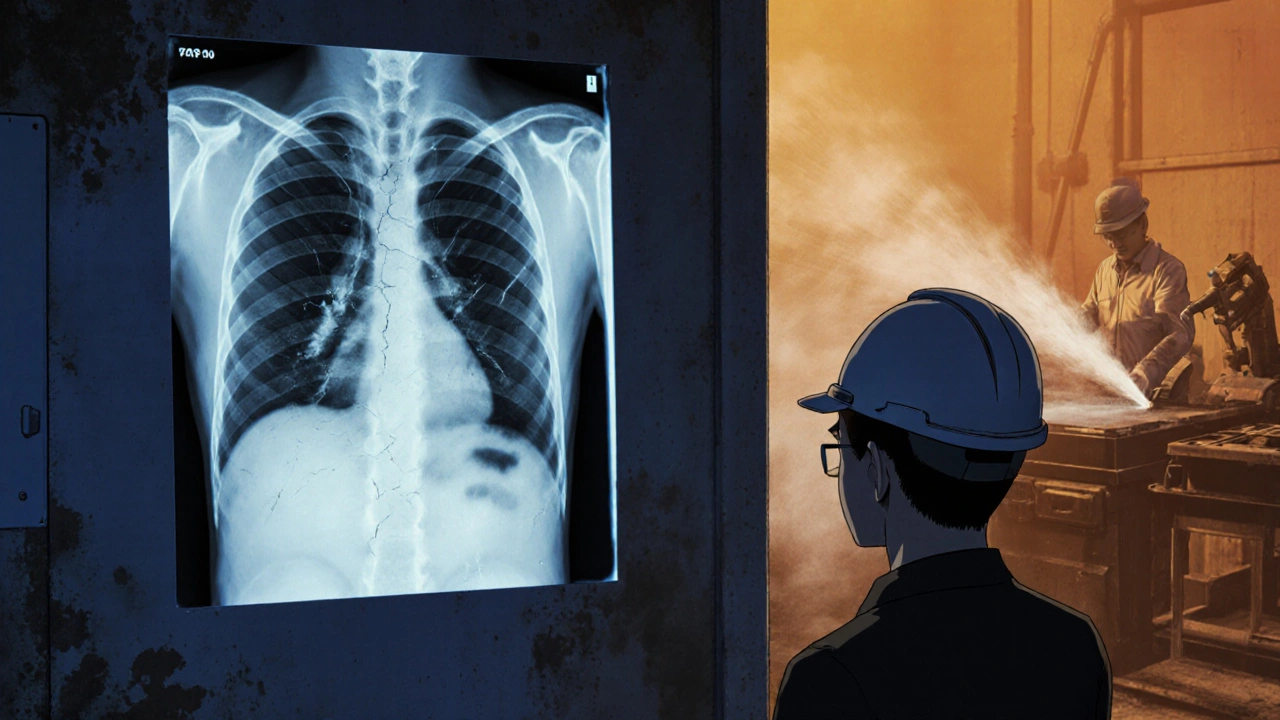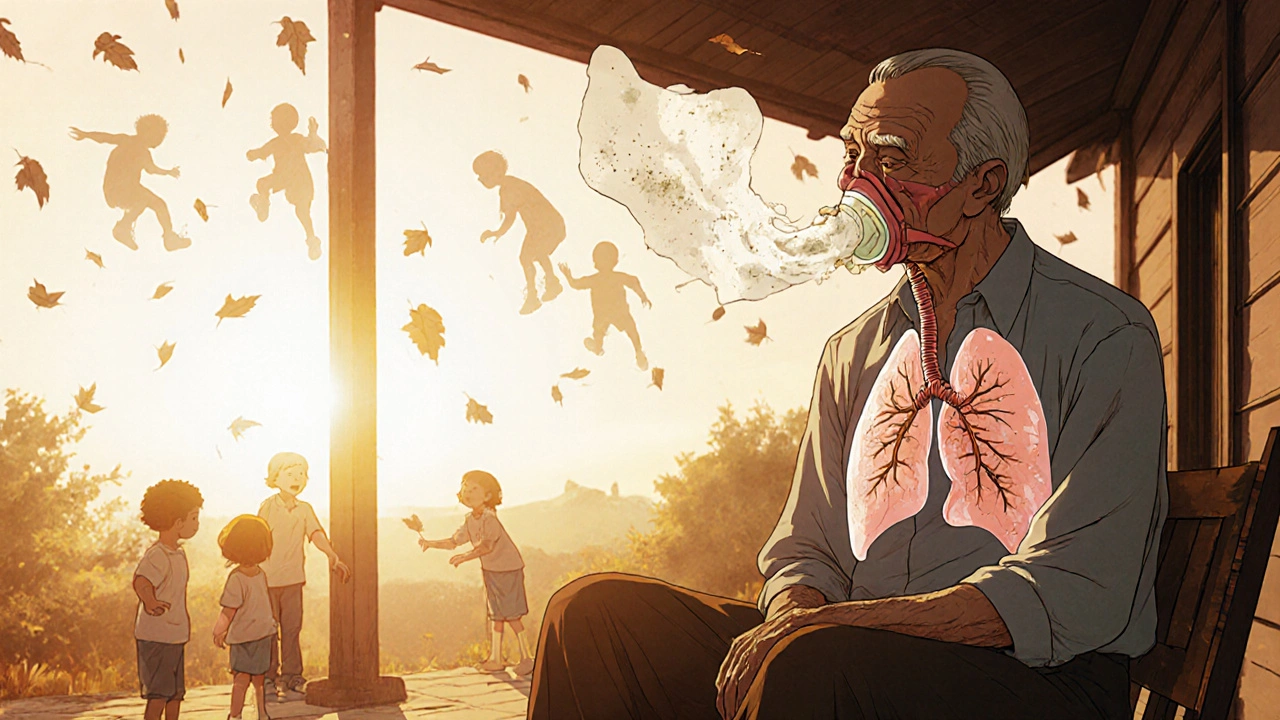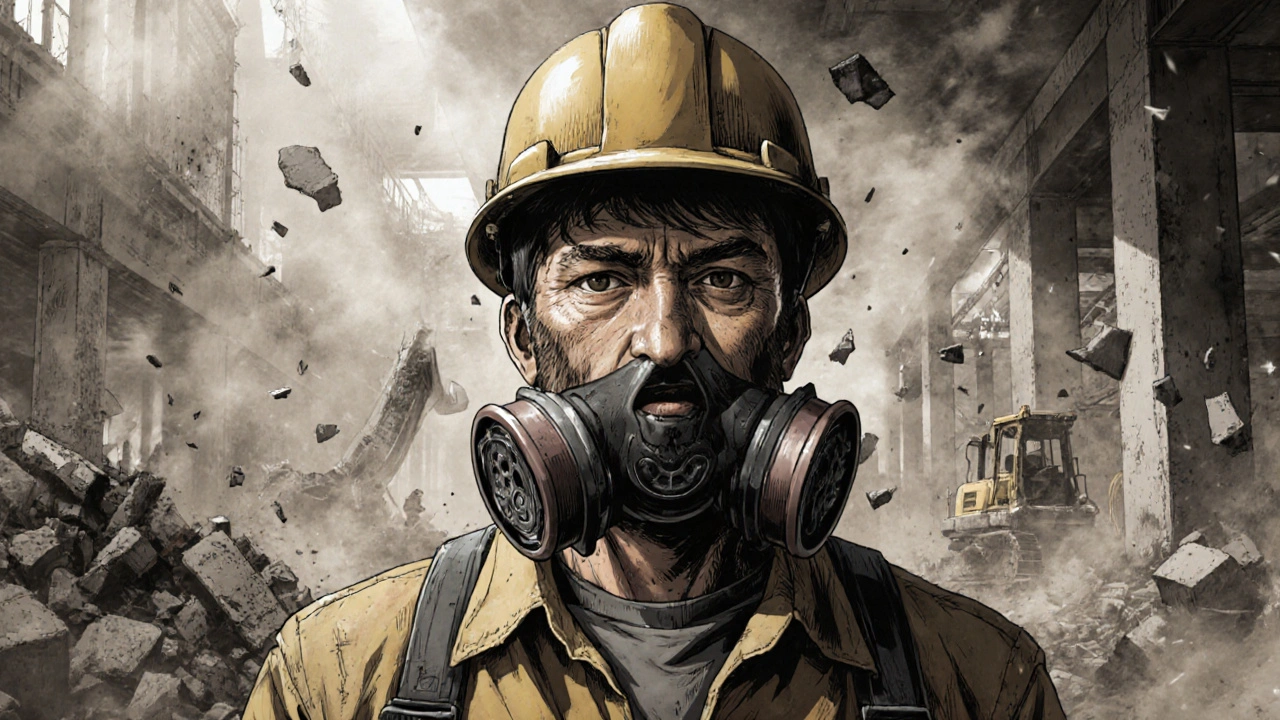Every year, thousands of workers breathe in dust and fibers they can’t see-and pay for it with their lungs. Silicosis and asbestosis aren’t rare anomalies. They’re preventable diseases that still kill people in construction sites, mines, and factories today. And the worst part? We’ve known how to stop them for decades.
What Silicosis and Asbestosis Actually Do to Your Lungs
Silicosis starts when you inhale crystalline silica dust. It’s in sand, stone, concrete, and even some ceramics. When you cut, grind, or drill these materials without protection, tiny particles get deep into your lungs. Your body tries to fight them off, but instead of clearing them, it scars the tissue. Over time, your lungs turn stiff and scarred, like old rubber. Breathing becomes harder. Coughing won’t go away. Eventually, you can’t get enough air-even walking short distances feels like climbing a mountain.
Asbestosis is similar, but it comes from asbestos fibers. These are thin, needle-like strands that were used in insulation, pipes, roofing, and brake pads for decades. Once inhaled, they stick to lung tissue and trigger chronic inflammation. The lungs thicken, lose elasticity, and can’t expand properly. People with advanced asbestosis often need oxygen tanks just to sleep.
Both diseases take years to show symptoms. You might feel fine for 10, 20, even 30 years after exposure. Then, one day, your body gives out. There’s no cure. Once the damage is done, it’s permanent.
Who’s at Risk? It’s Not Just Miners Anymore
People think these diseases only affect old-school miners or shipyard workers. That’s outdated. Today, the biggest risks are in construction. Tile installers cutting stone countertops. Roofers tearing off old shingles. Demolition crews breaking up concrete. Even landscapers grinding pavers can get exposed.
One study found that 1 in 5 workers in high-risk trades had signs of silica exposure on chest scans-even if they never had symptoms. And asbestos? It’s still in 733,000 public buildings in the U.S. alone. Renovating an old school, hospital, or apartment building can release fibers if not handled right.
And here’s the kicker: smoking makes it worse. If you smoke and work around silica or asbestos, your risk of developing lung disease goes up by 50 to 70%. Your lungs are already under stress. Adding dust or fibers on top? That’s a recipe for disaster.
The Hierarchy of Control: What Actually Works
There’s a clear order of what works best to stop these diseases-and most companies get it backward. They start with masks and hope for the best. That’s the weakest line of defense.
The real solution follows the hierarchy of controls:
- Elimination - Don’t use silica or asbestos at all. Replace granite countertops with engineered stone that’s silica-free. Use non-asbestos insulation.
- Substitution - If you can’t eliminate, use safer materials. Wet-cutting concrete instead of dry-cutting cuts silica dust by 90%.
- Engineering Controls - This is where most success happens. Local exhaust ventilation systems pull dust away at the source. When set up right, they reduce exposure by 80-90%. Water sprays on saws and drills trap dust before it becomes airborne.
- Administrative Controls - Limit exposure time. Rotate workers. Schedule dusty tasks for low-traffic hours.
- PPE - Respirators are the last line. N-95 masks filter 95% of particles. P-100s filter 99.97%. But here’s the problem: if they don’t fit right, they’re useless. And if they’re uncomfortable, workers take them off.
OSHA says PPE should only be used when other controls aren’t possible. But in real life? Many sites treat respirators like the main solution. That’s why 68% of worker complaints about respiratory protection are about fit and comfort.

Why Workers Stop Wearing Masks (Even When They Know Better)
It’s not laziness. It’s heat. It’s frustration. It’s being told to work faster.
On a 90-degree day, wearing a P-100 respirator feels like breathing through a wet towel. Workers sweat. Their glasses fog. They can’t talk clearly. Some modify them-cutting straps, loosening seals-just to get through the shift. That’s not rebellion. It’s survival.
One industrial hygienist on Reddit said compliance drops to 40% in summer. No mask. No protection. And supervisors? Often they don’t wear them either. If the boss doesn’t wear one, why should you?
Successful sites don’t just hand out masks. They train. They model. They check. One construction company in Wisconsin found that when supervisors wore respirators 100% of the time, worker compliance jumped from 52% to 89% in six months.
Testing and Monitoring: Catching It Before It’s Too Late
Most people don’t know they have silicosis or asbestosis until they’re gasping for air. That’s too late.
Spirometry tests measure how well your lungs work. They’re simple. You blow into a tube. The machine tells you how much air you can push out and how fast. It’s painless. It takes five minutes.
The American Thoracic Society says workers exposed to silica or asbestos should get tested at hire, then every five years. If you’ve got other lung issues-like asthma or COPD-you need it every year. Early detection can slow disease progression by 30-50%.
But only 22% of small construction firms with fewer than 20 employees offer regular lung testing. Why? Cost. Lack of awareness. It’s easier to ignore than to fix.

The Cost of Doing Nothing
Some bosses think safety is expensive. It’s not. It’s cheaper to prevent than to pay for.
A local exhaust system costs $2,000 to $5,000 per workstation. Sounds like a lot? Consider this: one worker’s workers’ compensation claim for silicosis can cost $300,000 or more-plus lost productivity, legal fees, and higher insurance rates.
OSHA fined construction companies over $3.2 million in 2021 just for silica violations. That’s not just fines. It’s reputational damage. Clients don’t want to hire companies that kill their workers.
And the human cost? There’s no price tag for a man who can’t play with his grandkids because he can’t breathe. Or a woman who dies at 58 because she was told asbestos was "safe" back in the 80s.
What’s Changing? Hope Is on the Horizon
There’s progress. NIOSH launched the "Prevent eTool" in 2023-a free digital guide for 15 high-risk industries. Companies using it saw a 40% drop in respiratory incidents in six months.
OSHA’s National Emphasis Program on silica has conducted over 1,200 inspections since 2022. More citations. More fines. More pressure to change.
In Europe, countries like Germany are piloting mandatory health monitoring. New cases are dropping by 55%. The goal? Eliminate all occupational lung diseases by 2030.
And technology is catching up. Wearable sensors now give real-time dust readings. If silica levels spike, your phone buzzes. You stop. You fix it. No waiting for an OSHA inspection.
You Can’t Unbreathe Dust. But You Can Stop It Before It Starts
Silicosis and asbestosis aren’t accidents. They’re failures. Failures of systems. Failures of leadership. Failures of will.
But they’re also fixable. We have the tools. We have the science. We have the laws.
What we need now is action. Not just from OSHA or the EPA. From you. From your boss. From your crew.
Ask: Are we using water on our saws? Are our respirators fit-tested? Are we getting lung scans? Is someone actually checking?
Because if you’re breathing in dust today, you’re not just risking your health. You’re betting your future. And that’s a bet no one should have to make.

dace yates
I never realized how many everyday jobs expose you to silica. I thought it was just miners and shipyards. My cousin’s a tile installer-he’s 34 and already has a persistent cough. He thinks it’s just allergies. I’m gonna send him this post.
Danae Miley
Correction: OSHA’s 2021 fines for silica violations totaled $3.2 million-not just for construction, but across all industries. Also, the American Thoracic Society recommends annual testing for those with pre-existing conditions, not just ‘if you’ve got other lung issues.’ Precision matters when lives are on the line.
Charles Lewis
It’s worth reflecting on the moral architecture of workplace safety. We have the knowledge, the technology, and the regulatory frameworks-but we lack the collective moral courage to implement them consistently. The hierarchy of controls isn’t just an engineering principle; it’s an ethical imperative. When we outsource protection to the individual-through respirators-we are, in effect, privatizing risk. The worker becomes the last line of defense against systemic negligence. This is not safety culture. This is sacrificial labor.
And yet, we praise the worker who wears the mask, when we should be condemning the boss who makes him need it in the first place.
Renee Ruth
Someone’s gonna cry about ‘cost’ again. Meanwhile, the guy who’s dying of silicosis at 52? He didn’t get a raise last year. He didn’t get a bonus. He didn’t get a ‘thank you.’ But his family? They’re gonna get a funeral bill, a lawsuit, and a lifetime of ‘what ifs.’ And the company? They’ll just rebrand as ‘Safety-Forward™’ and hire a new crew. This isn’t an industry. It’s a graveyard with a payroll.
Arpita Shukla
In India, we have similar issues with stone cutting in Agra and Jaipur. Workers use dry saws, no masks. They earn $3/day. Who cares? The government doesn’t test. The tourists buy the marble. The cycle continues. Your OSHA? We have no OSHA. We have ‘hope’ and ‘God’s will.’
Benjamin Stöffler
But… what if… the dust… isn’t the real problem? What if it’s the system? The capital? The commodification of breath? We treat lungs like disposable filters… and then blame the worker for breathing? And yet… we still have… commas… in our sentences… and… still… no… change…
Mark Rutkowski
There’s a quiet heroism in the guy who shows up every day, wears the mask even when it’s 95 degrees, and still finds the energy to laugh with his crew. We don’t celebrate that enough. We don’t build systems that honor that. We just expect it. But here’s the truth: you can’t ask someone to be brave on a daily basis without giving them the tools, the respect, and the safety net. We owe them more than a poster on the wall.
Ryan Everhart
So… we have sensors that buzz when silica spikes… and yet… we still have bosses who say ‘just power through’? Cool. I’ll just go ahead and add ‘modern slavery’ to the list of things we’ve branded as ‘progress.’
David Barry
Australia’s got the same BS. Demolition crews in Sydney still dry-cut asbestos-laden brick. OSHA? We’ve got WorkSafe. Same crap. Different flag. And the union? Too busy negotiating coffee breaks to fight for lung scans.
Alyssa Lopez
Yall need to chill. OSHA is overregulating. People gotta work. If you can’t handle a little dust, go work in an office. Also, granite is natural-so it’s fine. And respirators? Too expensive. We’re not Europe. We’re America. We don’t do ‘safe.’ We do ‘get it done.’
Alex Ramos
Big shoutout to the Wisconsin company that got 89% mask compliance by having bosses wear them too. That’s the move. 👊 Also, if your crew doesn’t have fit-tested P-100s, you’re not a boss-you’re a liability. Let’s fix this. 💪
edgar popa
My dad had asbestosis. He worked roofing. Never wore a mask. He’s gone now. Don’t be him.